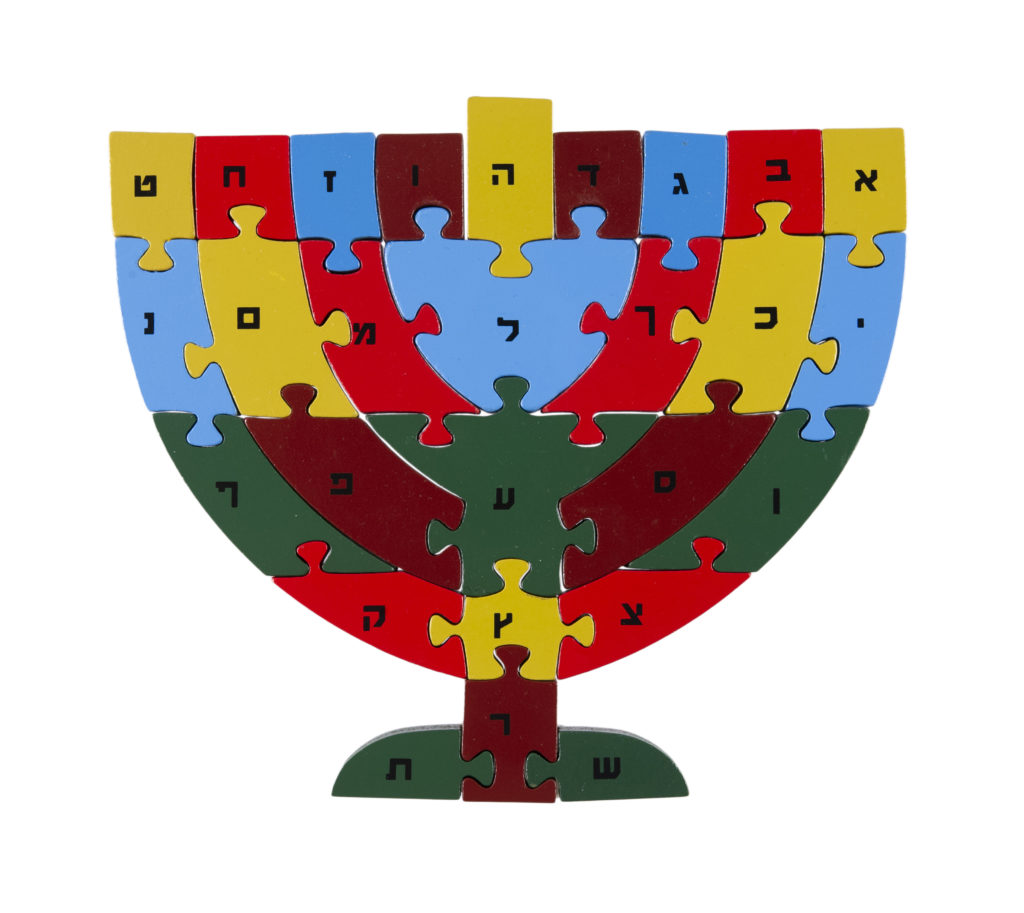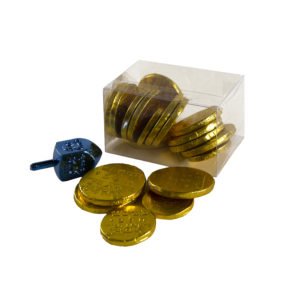Nosh and Natter – All About Hanukah

In Yiddish, “nosh” means “to snack” and “natter” is generally defined as a casual and leisurely conversation. What does food tell us about Jewish culture and faith? Talk with our team about how certain foods represent and celebrate important festivals and traditions – and have a taste for yourself.
For Hanukah, we will have samples of doughnuts for visitors to enjoy and learn about two of the greatest miracles in Jewish history. The date of Hanukah changes every year because it depends on the Hebrew calendar, but it always falls in November or December. In 2018, Hanukah begins on the evening of Sunday 2 December and ends on the evening of Monday 10 December. To celebrate, we will have samples of sufganiyot (jam doughnuts) from Monday 3 until Sunday 9 December.
We run ‘Nosh and Natter’ sessions for Jewish festivals throughout the year and it’s a great way for you to sample some Jewish foods and get to know us here at the museum.
Hanu-what?
What is Hanukah? Sometimes spelt “chanukah” or “hanukkah,” and pronounced as “HAH-nuh-kuh,” is the Jewish eight-day, wintertime “festival of lights.” Typically, it is celebrated with a nightly menorah lighting, special prayers and fried foods. In Hebrew, the word means “re-dedication” – celebrating the rededication (to God) of the Holy Temple in Jerusalem. Although Hanukah is not biblically ordained, it has become one of the most popular of the Jewish holidays. Here at the museum, we have chosen to use the spelling of ‘Hanukah’ to make it accessible to our non-Jewish visitors.
Hanu-where and -why?
Hanukah, the Jewish Festival of Lights, celebrates the rededication (to God) of the Holy Temple in Jerusalem. Over 2000 years ago, Jerusalem was ruled by the Syrian-Greeks. King Antiochus Epiphanes had banned all Jewish rituals and attempted to make Jewish people worship (bow down to) his statue which was placed in the Jewish temple – and also to pray to the Greek deities. Jewish people refused to worship in the temple – which had been turned into a pagan shrine!
A group of Jews, the Maccabees, rose up again the Greek rulers of Israel (one of the mightiest armies at the time) and drove them from the land. They reclaimed the Holy Temple and rededicated it to God. Or, to put it another way, they won a battle to practise their religion freely!
There is another hero associated with Hanukah: Judith. While not historically connected to the story of the Maccabees, the Book of Judith shares the theme of Jewish faith and courage overcoming a larger force. The town of Bethulia, in the land of Judea, came under siege by Holofernes, a Syrian-Greek general of a huge army, who was notorious for his cruelty in suppressing rebellions. In this instance, he cut off the food and water supply, until the town was brought to the verge of surrender. Judith went to Holofernes to give him news of the surrender of the Jewish people. When she returned to visit him, she fed him her famous goat cheese and it was so salty that he washed it down with copious amounts of wine. As he fell into a drunken sleep, she killed him (since you ask – she beheaded him). You might say that Judith understood the power of food and drink!
Hanu-how?

Gelt is the Yiddish for money and was traditionally given on Hanukah. Today, foil-covered chocolate coins are given instead. Also, there is also a (European) tradition to give small amounts of money as well as nuts and raisins to children.
How is Hanukah traditionally celebrated?
- Nightly menorah-lighting
A menorah (pronounced muh-NOHR-uh) is a nine-branched candelabrum – and has become a symbol for Hanukah and the Jewish faith, in general. A hanukkiyah or hanukkiah (pronounced hah-noo-kee-YAH) contains nine branches: one for each night of Hanukkah and an extra branch for the shamash (shah-MAHSH) which is “the helper” candle used to light the other candles.
Why is the menorah significant? The Holy Temple’s menorah was lit for eight days using only a single day’s supply of olive oil. (The Maccabees needed purified, sacred olive oil to light the lamps – this process takes around eight days.) The fact that the lamp remained lit for 8 days using a single batch of oil is why you might say: “a great miracle happened there” or “Nes Gadol Hayah Sham” (ness gah-DOHL high-YAH)!
- Play with a dreidel (pronounced DRAY-dull).
The Hebrew word for dreidel is “sevivon”. It is a spinning top, with four sides, each marked with a different Hebrew letter (nun, gimel, hay and shin). The letters on the dreidel are the first letters of the Hebrew phrase already mentioned: “A Great Miracle Happened There.”
The custom of playing dreidel on Hanukkah is based on a legend that, during the time of the Maccabees, when Jewish children were forbidden from studying Torah, they would defy the decree and study anyway. When a Greek official approached they would put away their books and took out spinning tops, to give the appearance that they were just playing game.
- A small present on each of the eight nights of Hanukah
Interestingly, some people wonder if this last tradition is really a Jewish tradition, or whether Hanukah presents just came about in reaction to Christmas! In other words – there is little to find (from exploring traditional texts) in terms of instructions on the proper giving of gifts during this festival. However, whilst gift giving is somewhat a new custom, the giving of Hanukah gelt is an old custom, practised in Europe for centuries.
Foods eaten at Hanukah
“Oil Vey!”
Since the Hanukah miracle involved oil, it is customary to eat foods fried in oil.
However, for many centuries, Hanukah was a minor holiday with no written history of traditional foods. Then, in the 14th century, we find writings in Italy about pancakes for the holiday made from ricotta cheese and fried in oil, an ideal dish combining the symbolic foods from the two stories associated with the holiday – oil and cheese.
Cheese pancakes for Hanukah remained popular in Europe for a few more centuries, and some Eastern European Jews served them with other dairy dishes such as cheesecake, sweet noodle kugels, cheese dumplings or fritters. In the 1850s, there were massive crop failures in the heart of the Ashkenazic world (Poland, Ukraine and territories in czarist Russia). To survive, the people planted cheap, easy-to-grow potatoes. Guess what they fried up for Hanukkah at that point?
Widely associated with the celebration of Hanukah, potato latkes are typically garnished with applesauce or sour cream. Pronounced LAHT-kuhs, these potato pancakes are fried in oil, of course. Pronounced either lot-key or lot-kuh, the origin of the word is Yiddish and means something along the lines of “little oily thing.” The Hebrew name for latke (leviva or לביבה ) refers in the Book of Samuel to a dumpling made from kneaded dough. Ashkenazi Jews have prepared latkes as part of the Hanukah festival since the mid-1800s.
Did Jew know? A typical Persian recipe for latkes involves more eggs used in proportion to the potato and the potatoes are cooked before they are grated, which makes for less time in the oil.
The history of Sufganiyot
Pronounced soof-gahn-ee-YOHT, these doughnuts are one of the most symbolic dishes of Hanukah. The first recipe for the jam doughnut was found in 1485, in a cookbook printed in Nuremberg, Germany. The original recipe didn’t have a hole, but rather was a pillow-like pocket of dough, filled with jam. The recipe instructed bakers to make a jam “sandwich” with two circular pieces of dough, to be fried in lard. The addition of jam was revolutionary, as doughnuts had been usually a savoury dish, filled with mushrooms, cheese or meat.
Consumption rose in the 1500s due to a drop in the cost of sugar. In particular, they were eaten in Poland during Christmas and Hanukah. They were known as paczki. In Yiddish, they were called ponchiks, and were fried in schmaltz (chicken or goose fat) or oil. Interestingly, unfilled doughnuts, in Yiddish, were simply “donats.”
Did Jew know? In the 1920s, the Israeli Labour Federation declared sufganiyot the official food of Hanukah. The idea was that by promoting doughnuts instead of latkes (which are easy to make at home), the baking, transporting, and merchandising behind every box of doughnuts would provide jobs!
Donuts around the world
Traditional sufganiyot are filled with red jelly (jam) and topped with icing sugar. However, many other varieties exist. Some Latin American Jewish communities fill them with dulce de leche, for example.
And, of course, you do not have to be Jewish to enjoy a doughnut. In India, you might find sweet pastries similar to old-fashioned doughnuts called badushahi (ring-shaped) and jalebi (pretzel-shaped). In Morocco, Sfenj is a similar pastry eaten sprinkled with sugar or soaked in honey. In Finland, sweet doughnuts called a munkki (the word also means monk) are popular, whilst in Greece, you might be partial to some loukoumas soaked in honey syrup. You will find ponchiki in Russia and, in the Netherlands, ask for oliebollen (“Dutch doughnuts”). Across the Atlantic, in Trinidad and Tobago, there are sweet, fried cube or rectangular-shaped doughnuts called kurmas whilst, in Peru, you can ask for picarones – which are shaped like doughnuts but made from a sweet potato or squash base. Interestingly, in the Philippines, you will find a twisted doughnut called shakoy – which somewhat resemble challah bread (plaited loaf typically eaten during Shabbat)!